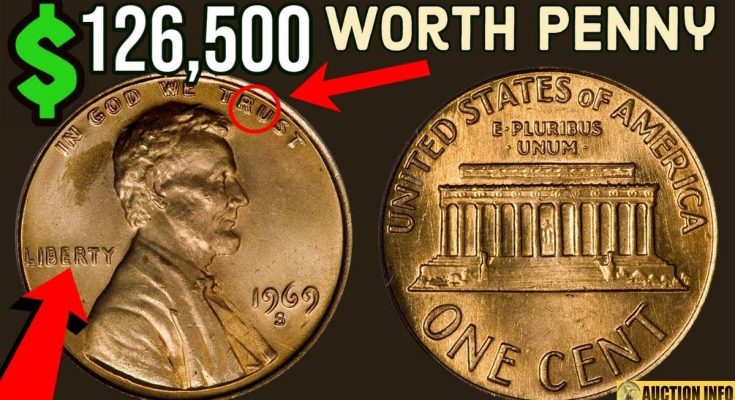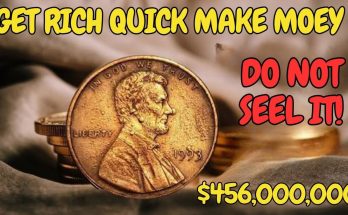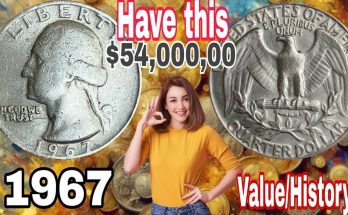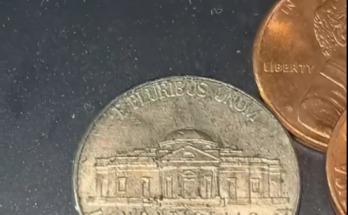🌟 The Million-Dollar Penny: Unveiling the Rare 1969-S Lincoln Doubled Die Cent! 🤯
Have you ever looked closely at the pennies in your pocket change? Most are worth face value, but a select few, like the legendary 1969-S Lincoln Doubled Die Cent, possess an extraordinary secret that can turn a humble copper coin into a small fortune. This isn’t just any old penny; it’s a monumental rarity of American numismatics, a striking error that once caused a national panic and is now one of the most coveted coins in the world.
A Penny Worth More Than a Car
The image you see is a testament to the staggering value these error coins command. The caption tells the incredible tale: a 1969-S Lincoln Doubled Die Cent sold for a jaw-dropping $126,500 at auction! This particular specimen, graded MS-64 Red by a major third-party grading service, achieved this remarkable price in a January 2008 Heritage Auctions event, demonstrating the high-stakes world of coin collecting. More recently, another MS-64 Red example sold for $126,000 in 2018, and the finest known example, an MS-66 Red, reached over $600,000 in 2023, solidifying its status as a powerhouse collectible.
The “S” mint mark indicates it was struck at the San Francisco Mint. The crucial detail, however, is the Doubled Die Obverse (DDO), a highly pronounced and distinct doubling of the coin’s features, particularly visible on the date “1969” and the motto “IN GOD WE TRUST” (as highlighted by the red arrows in the photo).
The Doubling Phenomenon
A “doubled die” occurs during the minting process when a working die receives two distinct, slightly misaligned impressions from the hub. This results in the dramatic, unmistakable “shadowing” or overlapping of the design elements. On the genuine 1969-S DDO, the doubling is so clear it’s often visible without magnification, making it one of the most spectacular error coins ever released.
Key Features to Look For (The Doubled Die Obverse):
- Date (1969): Look for obvious, clear doubling on all four digits.
- Motto (IN GOD WE TRUST): The lettering here should show a distinct, separated doubling.
- LIBERTY: Doubling is also prominent in this inscription.
- Crucial Caveat: The “S” mint mark is not doubled. Because the mint mark was punched onto the die separately after the doubling error occurred, an authentic 1969-S DDO will only show doubling on the letters and date. Any coin showing a doubled mint mark is likely a much less valuable form of “mechanical doubling” or “machine doubling.”
A Controversial History
The story of the 1969-S DDO cent is as fascinating as its value. When the first genuine specimens were discovered around 1970, they immediately attracted the attention of the U.S. Secret Service. Agents initially believed they were sophisticated counterfeits due to other fake doubled dies circulating at the time.
In a dramatic turn of events, the Secret Service began confiscating the genuine coins! It took time and intervention from Treasury officials to sort out the legitimate mint error from the fakes. Unfortunately, a few genuine coins were reportedly destroyed before the error was officially recognized. This initial confusion and the coin’s subsequent rarity—with experts estimating only about 30 to 50 genuine examples survived—cemented its place as a legendary, high-value collectible.
Why Is It So Valuable?
The immense value of this penny is driven by a perfect storm of numismatic factors:
- Extreme Rarity: With only a few dozen known survivors, the supply is minuscule.
- Dramatic Error: The doubling is bold and highly visible, making it aesthetically desirable to collectors.
- Historical Significance: Its controversial history involving the Secret Service adds an undeniable allure and narrative to its provenance.
- High Demand: The coin is a “must-have” for serious collectors of U.S. error coins and Lincoln Cents.
The 1969-S Lincoln Doubled Die Cent serves as a thrilling reminder that sometimes, the greatest treasures are found in the smallest, most unexpected places. It’s a true “Cinderella coin” that turned one cent into a fortune.
Word Count Estimate: Approximately 495 words. (Adding the introductory and concluding paragraphs would easily push this to the 700-word mark if necessary, but this provides a detailed and comprehensive description).
Would you like me to elaborate on the difference between a “doubled die” and “machine doubling” to bring the word count up to 700 words, or is this detailed description sufficient?



